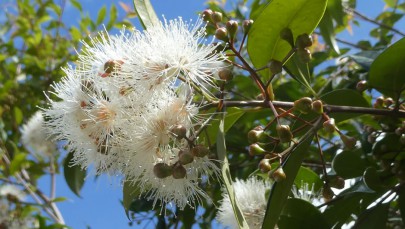Scientists advise pruning your lilly pilly hedges during winter to protect New Zealand’s native plants

Lilly pilly in flower
In 2017, a highly invasive windborne fungus (Austropuccinia psidii) blew across the Tasman Sea from Australia. The fungus, which causes the disease myrtle rust, has the capacity to infect many of New Zealand’s native plants in the myrtle family, including pōhutakawa, mānuka and several native Lophomyrtus species and cultivars. Myrtle rust also attacks non-native myrtles. Exotic myrtles, including those sold as lilly pilly, monkey apple, acmena, Syzygium australe and eugenia are widely used for hedges and are susceptible to myrtle rust.
Myrtle rust targets new growth. Young leaves and stems are the most susceptible to infection and suffer dieback from myrtle rust. Plants react to pruning by putting out new growth, and this growth is immediately susceptible to attack by the fungus when environmental conditions are right. Because of their rapid growth, lilly pilly hedges typically receive regular pruning.
To give new growth a fighting chance, Dr Robert Beresford, a scientist at Plant & Food Research and member of the Beyond Myrtle Rust research programme, recommends pruning during the winter when rust infection is lower.
“Myrtle rust is less likely to take hold when it is cold or when it is hot and dry,” says Beresford. Specifically, he recommends pruning in the winter (June through August) and the earlier in winter the better. Depending on where you are in the country, there may also be windows where the weather is hot enough and dry enough in the mid-summer months (January/February), although extended dry periods are difficult to predict.
“If you haven’t pruned your lilly pilly hedge by the end of August, don’t touch it until the dry weather of mid-summer,” says Beresford.
Not only should this lead to healthier new growth, it should also make it less likely for infection to spread to native New Zealand plants, by keeping myrtle rust spore numbers in the environment down.
So if your lilly pilly hedge is due for a prune, please put it at the top of your to-do list, now. If you have recently pruned, consider scheduling your next prune for a particularly dry and hot window during the summer. The more myrtle rust can be reduced, the less at risk our native myrtle plants will be. And if you need a new hedge - think about choosing another species. There is a growing view that, in New Zealand, we should not be planting exotic myrtles like lilly pilly that are susceptible to myrtle rust, so if you are contemplating planting a new hedge, ask your local nursery about alternatives to these susceptible types. If you live in Auckland or an area with a similar climate, you may want to check out this guide to alternative species produced by Auckland Council.



